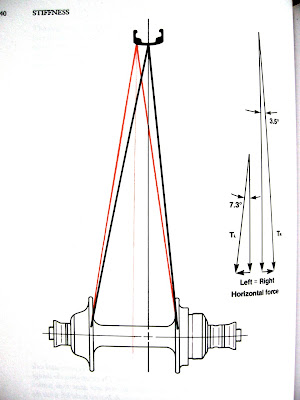There are two alternatives to asymmetry in the spoke tensions of rear wheel:
- Asymmetric frame
- Asymmetric rim (with non-centered spoke holes)
Traditionally, the way asymmetry is handled is in spoke tensions. It should be noted that the author of The Bicycle Wheel is a prophet of doom. There are the following examples in the book as the degree of asymmetry:
- Six-speed: 1.6 : 1
- Seven-speed: 2.0 : 1
- Eight-speed: 2.5 : 1
It is implied (but not said) that adding every speed increases the ratio by approximately 0.5 so that eleven-speed would be 4.0 : 1. This is not the case. Firstly, all Shimano freehubs between eight-speed and ten-speed use the same freehub width because they are cramming more sprockets in the same space. Secondly, 2.5 : 1 is not certainly true for Shimano 8-speed freehubs. For example, Shimano FH-T610 135mm OLD freehub has 1.8 : 1 as the asymmetry. This is partly caused by it being 135mm as opposed to 130mm which road freehubs are. However, even Shimano FH-5600 is 2.1 : 1 as an example of a 130mm OLD hub and certainly not 2.5 : 1. Even Shimano FH-5800 (130mm OLD, 11 speed) is only 2.2 : 1 and not 2.5 : 1. So it appears that even Shimano 11-speed 130mm OLD freehubs, the most extreme asymmetry there is, are only 2.2 : 1 so the 2.5 : 1 stated in the book is very suspicious.
Secondly, road freehubs are moving due to adoption of disc brakes towards 142mm M12 thru axle (which roughly corresponds to 135mm quick release and is certainly much wider than 130mm quick release). FH-R7070, an example of 11-speed 142mm M12 hub, is 1.8 : 1, the same as 8-speed 135mm OLD quick release rim brake hubs.
So the problem is not as bad as it is claimed in the book. Certainly however an over 100 kg rider should avoid using a 130mm OLD 11-speed road bike in offroad situations if using 23mm tires pumped to over 120 psi, especially if the spoke count is lower than the optimal 36, but that should be obvious anyway.
So let's consider the alternatives to spoke tension asymmetry:
Rim asymmetry
The problem of rim asymmetry is that it typically modifies the rear rim to be different from the front rim. Thus, every bicyclist having a stock of rims in home needs after this modification two stocks of rims: a stock of rear rims and a stock of front rims. The doubled rim stock costs makes this solution rather poor. There are two alternatives to this: firstly, it is possible to make the rim asymmetry half of the rear wheel natural spoke tension asymmetry. It might allow using the same asymmetric rims in both front and rear wheels. Secondly, with the advent of disc brakes, it is possible to take the rear rim, reverse it and install it to a front wheel. Disc brake front wheels too are asymmetric but in the opposite way.
Traditionally bicycles used rim brakes and the desire to have only one rim type made rim asymmetry quite rare. However, disc brakes and reversing the rear rim in the front could make this solution viable today. I wonder why asymmetric rims are not becoming very common today. Perhaps bike manufacturers have not realized the usefulness of asymmetric rims as the standard rim in disc brake bicycles.
Frame asymmetry
The problem of frame asymmetry is chainline. Today the best bottom bracket standard is probably Hollowtech II and Hollowtech II cranksets have fixed chainline. You can't adjust it like you could with square taper bottom brackets. So an asymmetric frame would have a chainline optimized only for the big ring, and the little ring would be useful only with the very largest sprockets. Not very desirable. Of course an option could be to use non-standard crankset parts for modified chainline.
Today, with the advent of mid-drive electric bikes this frame asymmetry may actually be useful. Mid-drive units are rather wide so they typically are used with only one chainring. If you want a typical road bike 2x setup in a mid-drive bike, the logical way to install the second ring is to increase the Q factor of the crankset and put the second chainring in the freed space. With standard non-asymmetric frame, the second chainring would be too outboard. However, with an asymmetric frame the second chainring could be just in a useful position.
My electric bike, Cannondale Synapse Neo EQ, uses this concept of using asymmetric frame with mid-drive. It has a frame asymmetry of 6mm, called Cannondale AI. I think it's useful in this very bike although for non-electric bikes it would be less useful.

